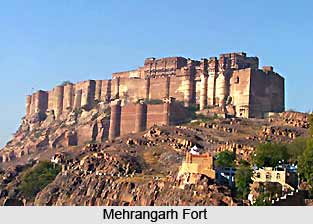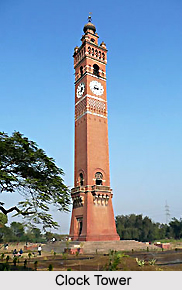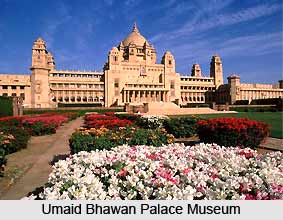 Monuments of Jodhpur display a fine exhibition of local vernacular architecture. There are a number of famous palaces and forts which figure among the monuments of Jodhpur. Each of them has a history behind it, telling an ancient story of Rajput rule. Once the capital of the old princely state of Marwar, Jodhpur ranks as the second largest city of Rajasthan. It was a prime city for trade and commerce between the east and the west. After the defeat of the Rathors of Kanauj in 1211, Rao Siha came to Rajasthan and founded a settlement here. Later the Rajputs established themselves in Marwar with Mandor as the capital. Jodhpur was founded by Rao Jodha in 1459, after he had been expelled from Mandor, which was too vulnerable. As a result the site of Jodhpur was chosen which was impregnable, dominating the Thar Desert. Currently, the old city of Jodhpur is surrounded by a stone wall and the new city is on the other side of the railway tracks, in the southeastern direction.
Monuments of Jodhpur display a fine exhibition of local vernacular architecture. There are a number of famous palaces and forts which figure among the monuments of Jodhpur. Each of them has a history behind it, telling an ancient story of Rajput rule. Once the capital of the old princely state of Marwar, Jodhpur ranks as the second largest city of Rajasthan. It was a prime city for trade and commerce between the east and the west. After the defeat of the Rathors of Kanauj in 1211, Rao Siha came to Rajasthan and founded a settlement here. Later the Rajputs established themselves in Marwar with Mandor as the capital. Jodhpur was founded by Rao Jodha in 1459, after he had been expelled from Mandor, which was too vulnerable. As a result the site of Jodhpur was chosen which was impregnable, dominating the Thar Desert. Currently, the old city of Jodhpur is surrounded by a stone wall and the new city is on the other side of the railway tracks, in the southeastern direction.
In Jodhpur are seen many new designs of architecture. A strong influence of Islamic architecture can be seen among the various monuments of Jodhpur. Indo- Saracenic style is the most dominant feature of the various constructions of monuments.
< Jodhpur abounds in a number of historic monuments carrying in them the legacy of the Rajput rulers. One of the prime monuments of Jodhpur is the Mehrangarh fort. It is situated 400 feet above the plain on a steep escarpment. There is a drop of 120 feet at the South end. The fort is enclosed by a high wall with bastions. The summit is divided into three areas: the palace to the north-west, the strongly fortified area to the south edge of the cliff and a long, wide terrace to the east of the palace. The approach to the fort is via seven huge gateways on the west side of the hill.
Jodhpur abounds in a number of historic monuments carrying in them the legacy of the Rajput rulers. One of the prime monuments of Jodhpur is the Mehrangarh fort. It is situated 400 feet above the plain on a steep escarpment. There is a drop of 120 feet at the South end. The fort is enclosed by a high wall with bastions. The summit is divided into three areas: the palace to the north-west, the strongly fortified area to the south edge of the cliff and a long, wide terrace to the east of the palace. The approach to the fort is via seven huge gateways on the west side of the hill.
Found within the fortifications are a number of palaces and other constructions. The Old Palaces are a series of interconnecting courtyards surrounded by ranges of buildings with intricate carved stonework and beautiful filigree sandstone windows. Commenced in 1499, the surviving apartments generally date from 1640 onwards. The palaces found herein are the Moti Mahal, Phool Mahal, Sukh Mahal, Zanki Mahal, Umaid Mahal, Zenana Mahal, Sheesh Mahal, Rang Mahal and Chandan Mahal. Also found within are the Sileh Khana or the armoury, the Takhat Vilas, cenotaphs and ancient canons, galleries and museums.
 Located to the left of the Mehrangarh fort complex is the Jaswant Thada of Jodhpur. It is a nineteenth century royal cenotaph which has been built in commemoration of Maharajah Jaswant Singh II. The tomb was built by the son of the Maharajah, and the main memorial has been constructed to resemble a temple. There are two more cenotaphs near the tomb. Close to this, is the royal crematorium and three other cenotaphs. The Jaswant Thada is a white marble memorial with intricate carvings. The stones are extremely thin and polished. Also found on the cenotaph is a beautiful marble jail work.
Located to the left of the Mehrangarh fort complex is the Jaswant Thada of Jodhpur. It is a nineteenth century royal cenotaph which has been built in commemoration of Maharajah Jaswant Singh II. The tomb was built by the son of the Maharajah, and the main memorial has been constructed to resemble a temple. There are two more cenotaphs near the tomb. Close to this, is the royal crematorium and three other cenotaphs. The Jaswant Thada is a white marble memorial with intricate carvings. The stones are extremely thin and polished. Also found on the cenotaph is a beautiful marble jail work.
Apart from the fort and the monuments contained within it, certain other monumental structures can also be found in the city of Jodhpur. The Umaid Bhavan Palace was built between 1929 and 1944 as a famine relief exercise. It was designed by Henry Lanchester, an architect with a keen interest in Baroque civic classicism. This vast monolithic pile is conceived in the classical grand manner, but on an Indian plan. It contains 347 rooms, including eight dining-halls. The nuances and details are Hindu and the materials, red sandstone and marble. The Umaid Bhavan Palace is now a hotel. A part of the Palace is still occupied by the descendants of the Maharajah. Recently, the Royal family has allowed a part of the museum to be converted to a museum.
The Umaid Bhawan Palace Museum exhibits a fine collection of items of royal use. Found here is a large collection of ornate mirrored furniture, rare collection of clocks and watches, fine China, glass and crystal ware, old photographs etc.
One of the oldest landmarks in the city is the Clock Tower. It stands in the midst of the busy Sadar Market area within the old city. It is an ornate structure constructed in the nineteenth century.
The Rai ka Baag Palace lies to the South-East of the new city. It was built by the Queen of Maharajah Jaswant Singh I in 1663. This palace was among one of the favourites of the King and he often stayed here. At present the palace houses the income tax office.
A number of palaces have now been converted for purposes of civic use. The Tulahati Mahal built by Jaswant Singh I, is now a women`s hospital. The Ratnada Palace has now been given over for military use.
The monuments of Jodhpur are famous for their architectural and construction styles. They are still preserved in a good condition today mainly due to the combined efforts of the Tourism department of Rajasthan Government and the Royal Families of Rajasthan.




